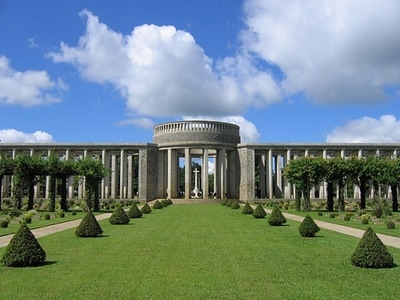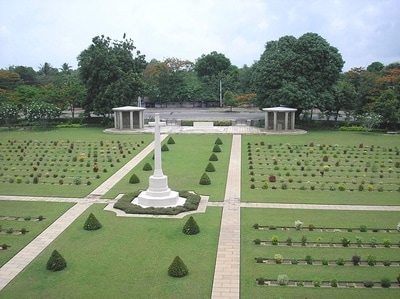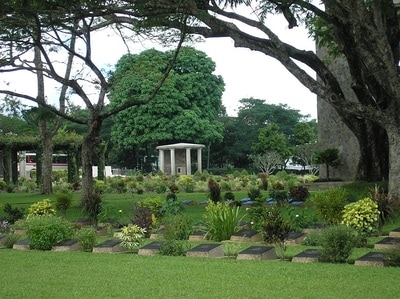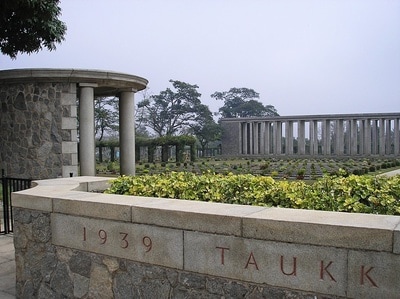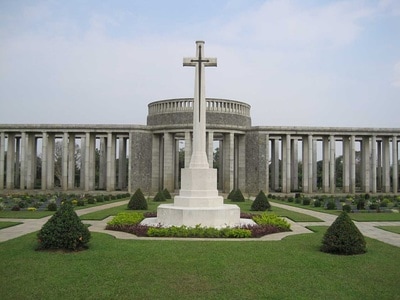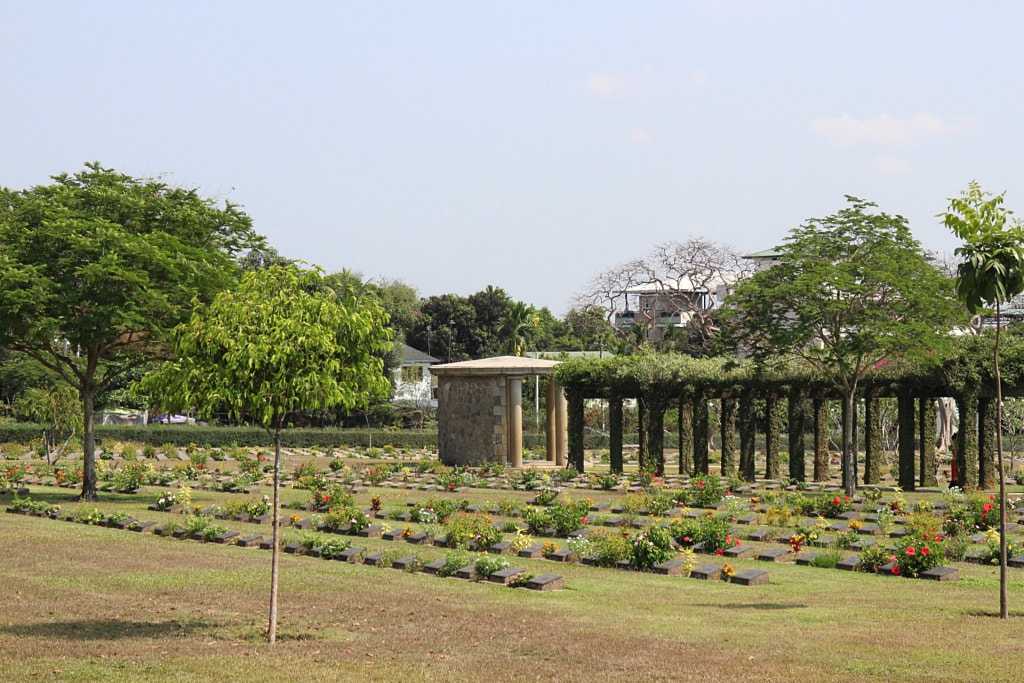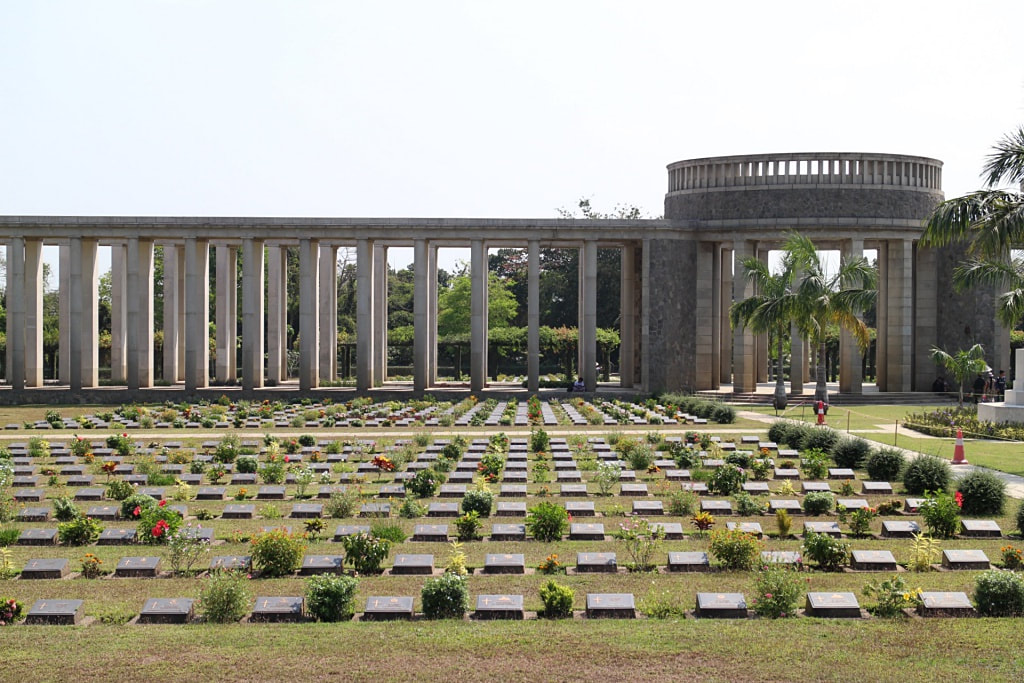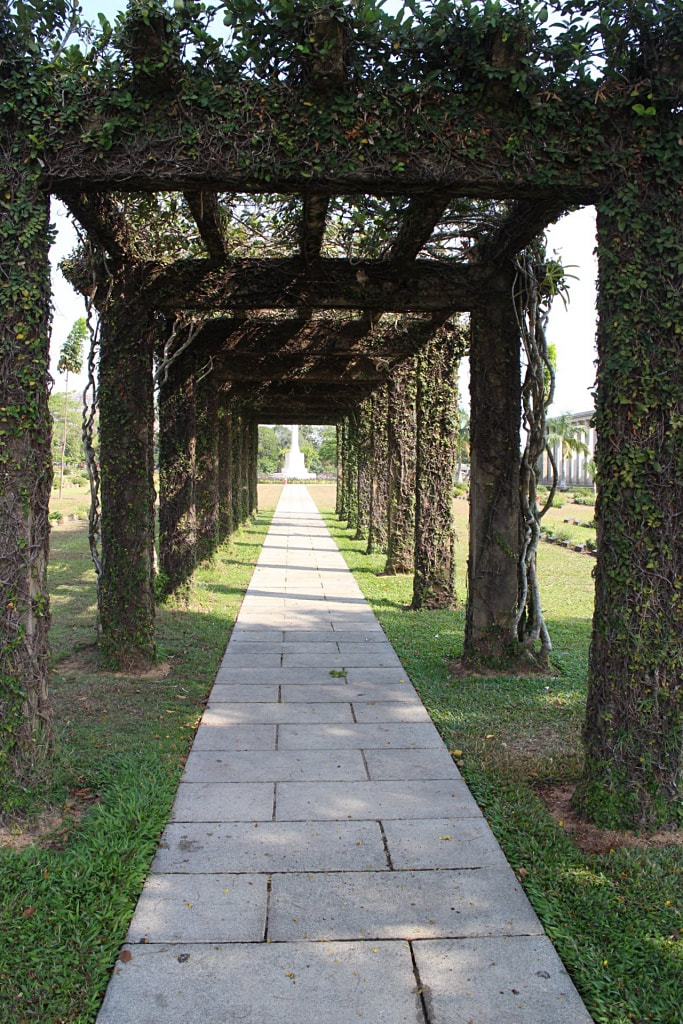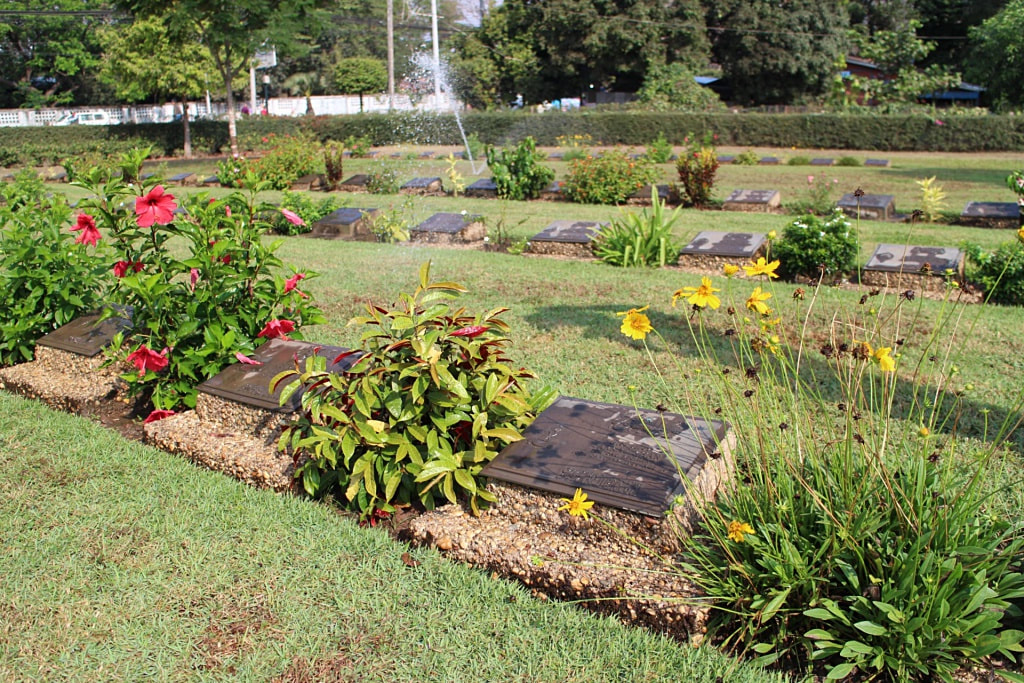TAUKKYAN WAR CEMETERY
Yangon
Myanmar
GPS Coordinates: Latitude: 17.03567, Longitude: 96.13127
Location Information
Taukkyan War Cemetery is in Taukkyan town in the township of Mingaladon, Yangon greater area, on the main highway No 1 (Pyay Road). From the centre of the city of Yangon, it is 21 miles north and 11 miles from the International airport, 1 hour drive from the centre of Rangoon and 30 minutes from the International airport. Exact location of the cemetery is North (17º02'08.24") and East (96º07'55.28").
Visiting Information
Accompanied wheelchair access is possible through the main entrance and if unaccompanied through the side entrance adjacent to the office. The cemetery is open everyday from 07:00-17:00.
Historical Information
TAUKKYAN WAR CEMETERY is the largest of the three war cemeteries in Burma (now Myanmar). It was begun in 1951 for the reception of graves from four battlefield cemeteries at Akyab, Mandalay, Meiktila and Sahmaw which were difficult to access and could not be maintained. The last was an original 'Chindit' cemetery containing many of those who died in the battle for Myitkyina. The graves have been grouped together at Taukkyan to preserve the individuality of these battlefield cemeteries
Burials were also transferred from civil and cantonment cemeteries, and from a number of isolated jungle and roadside sites. Because of prolonged post-war unrest, considerable delay occurred before the Army Graves Service were able to complete their work, and in the meantime many such graves had disappeared. However, when the task was resumed, several hundred more graves were retrieved from scattered positions throughout the country and brought together here.
The cemetery now contains 6,392 Commonwealth burials of the Second World War, 867 of them unidentified.
In the 1950s, the graves of 52 Commonwealth servicemen of the First World War were brought into the cemetery from the following cemeteries where permanent maintenance was not possible: Henzada (1); Meiktila Cantonment (8); Thayetmyo New (5); Thamakan (4); Mandalay Military (12) and Maymyo Cantonment (22).
World War One Identified Casualties: United Kingdom 51, India 4. Total 55.
World War Two Identified Casualties: United Kingdom 3,872, India 1,562, Canada 58, Australia 23, New Zealand 7, South Africa 3. Total 5,525.
World War Two Unidentified Casualties: 867.
Taukkyan War Cemetery also contains:
The RANGOON MEMORIAL, which bears the names of 26,856 men of the Commonwealth land forces who died during the campaigns in Burma and who have no known grave.
Commemorated: India 19,640, United Kingdom 7,167, South Africa 46, Australia 2, Canada 1. Total 26,856.
The TAUKKYAN CREMATION MEMORIAL commemorating more than 1,000 Second World War casualties whose remains were cremated in accordance with their faith.
Commemorated: India 980, United Kingdom 80. Total 1,060.
The TAUKKYAN MEMORIAL which commemorates 46 servicemen of both wars who died and were buried elsewhere in Burma but whose graves could not be maintained.
Commemorated from World War One: United Kingdom 20.
Commemorated from World War Two: United Kingdom 22, India 2, New Zealand 2. Total 26.
Cemetery pictures in gallery below used with the permission of the Commonwealth War Graves Commission
Victoria Cross Recipients
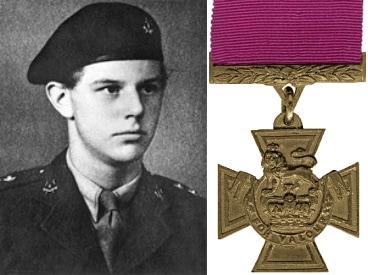
EC/8188 Captain
Michael Allmand, V. C.
Indian Armoured Corps, attached to 3rd Bn. 6th Gurkha Rifles
24th June 1944, aged 20.
Plot 13. A. 4.
Son of Arthur John and Marguerite Marie Allmand, of Golders Green, London.
His headstone bears the inscription "Requiescat In Pace"
Citation:
The following details are given in the London Gazette of October 26th, 1944:-The 6th Gurkha Rifles in Burma were ordered on 11 June, 1944, to attack Pin Hmi road Bridge. The approach to the bridge was held by the Japanese, who were delaying the advance by the most desperate resistance. Captain Allmand's platoon was leading the attack but suffered severe casualties and was forced to seek cover. Captain Allmand, however, charged on by himself, hurling grenades into the enemy gun positions and killing three Japanese with his kukri. Inspired by this action the surviving men of his platoon captured their objective. Two days later, personally killing a number of enemy machine gunners, he successfully led his men and captured another objective. On June 23rd, in the final attack on the railway bridge at Mogaung, despite trench-feet, Captain Allmand moved forward alone and charged a machine-gun nest single handed. He was mortally wounded and died shortly afterwards. The superb gallantry, outstanding leadership and protracted heroism of this very brave officer were a wonderful example to the whole battalion and in the highest traditions of his regiment
Michael Allmand, V. C.
Indian Armoured Corps, attached to 3rd Bn. 6th Gurkha Rifles
24th June 1944, aged 20.
Plot 13. A. 4.
Son of Arthur John and Marguerite Marie Allmand, of Golders Green, London.
His headstone bears the inscription "Requiescat In Pace"
Citation:
The following details are given in the London Gazette of October 26th, 1944:-The 6th Gurkha Rifles in Burma were ordered on 11 June, 1944, to attack Pin Hmi road Bridge. The approach to the bridge was held by the Japanese, who were delaying the advance by the most desperate resistance. Captain Allmand's platoon was leading the attack but suffered severe casualties and was forced to seek cover. Captain Allmand, however, charged on by himself, hurling grenades into the enemy gun positions and killing three Japanese with his kukri. Inspired by this action the surviving men of his platoon captured their objective. Two days later, personally killing a number of enemy machine gunners, he successfully led his men and captured another objective. On June 23rd, in the final attack on the railway bridge at Mogaung, despite trench-feet, Captain Allmand moved forward alone and charged a machine-gun nest single handed. He was mortally wounded and died shortly afterwards. The superb gallantry, outstanding leadership and protracted heroism of this very brave officer were a wonderful example to the whole battalion and in the highest traditions of his regiment

193864 Major
Frank Gerald Blaker, V. C., M. C.
Highland Light Infantry (City of Glasgow Regiment), attached to 3rd Bn. 9th Gurkha Rifles
died 9th July 1944, aged 24.
Plot 6. E. 2.
Citation:
The following details are given in the London Gazette of September 22nd, 1944 - In Burma on 9th July, 1944 a company of the 9th Gurkha Rifles was ordered to carry out a movement across unknown precipitous country, through dense jungle, to attack an enemy strong point on the summit of a hill overlooking Taungni. Major Blaker carried out this movement with the utmost precision, in itself a feat of considerable military skill, and the company took up a position on the extreme right flank of the enemy. At this crucial moment the company's advance was completely stopped by heavy and accurate enemy fire. Major Blaker, although severely wounded in the arm, then advanced ahead of his men, located and charged single-handed, the Japanese machine-guns. When hit by three rounds through the body, he continued to cheer on his men while lying on the ground. His fearless leadership and outstanding courage so inspired his company that they captured the positiion. Major Blaker died of his wounds. His heroism and self-sacrifice were beyond all praise and contributed in no small way to the defeat of the enemy and the successful outcome of the operations.
Frank Gerald Blaker, V. C., M. C.
Highland Light Infantry (City of Glasgow Regiment), attached to 3rd Bn. 9th Gurkha Rifles
died 9th July 1944, aged 24.
Plot 6. E. 2.
Citation:
The following details are given in the London Gazette of September 22nd, 1944 - In Burma on 9th July, 1944 a company of the 9th Gurkha Rifles was ordered to carry out a movement across unknown precipitous country, through dense jungle, to attack an enemy strong point on the summit of a hill overlooking Taungni. Major Blaker carried out this movement with the utmost precision, in itself a feat of considerable military skill, and the company took up a position on the extreme right flank of the enemy. At this crucial moment the company's advance was completely stopped by heavy and accurate enemy fire. Major Blaker, although severely wounded in the arm, then advanced ahead of his men, located and charged single-handed, the Japanese machine-guns. When hit by three rounds through the body, he continued to cheer on his men while lying on the ground. His fearless leadership and outstanding courage so inspired his company that they captured the positiion. Major Blaker died of his wounds. His heroism and self-sacrifice were beyond all praise and contributed in no small way to the defeat of the enemy and the successful outcome of the operations.

198186 Lieutenant
George Albert Cairns, V. C. Mentioned in Despatches.
Somerset Light Infantry, attached to (Airborne) South Staffordshire Regiment
19th March 1944, aged 30.
Plot 6. A. 4.
Son of Albert Henry and Rose Sophia Cairns; husband of Ena Kathleen Cairns, of Sidcup, Kent. Served with the "Chindits.".
His headstone bears the inscription "Theres's Some Corner Of A Foreign Field That Is For Ever England"
Citation:
The following details are given in the London Gazette of September 4th, 1945: At Henu, near Broadway (Burma) on March 12th, 1944, the South Staffordshire Regiment, which formed a part of the 77th Independent Infantry Brigade, together with the 3rd/6th Gurkha Rifles established a road and rail block across the Japanese lines of communication. The following morning the Japanese counter-attacked heavily, and the South Staffordshire Regiment were ordered to attack a hill-top which formed the basis of the Japanese assault. During this action a Japanese officer attacked Lt. Cairns, and with his sword hacked off his left arm. Lt. Cairns killed this officer, picked up the sword and with it killed or wounded several Japanese, still at the head of his men, before he himself fell to the ground. He subsequently died from his wounds. His action so inspired all his comrades that later the Japanese were completely routed, a very rare occurrence at that time.
George Albert Cairns, V. C. Mentioned in Despatches.
Somerset Light Infantry, attached to (Airborne) South Staffordshire Regiment
19th March 1944, aged 30.
Plot 6. A. 4.
Son of Albert Henry and Rose Sophia Cairns; husband of Ena Kathleen Cairns, of Sidcup, Kent. Served with the "Chindits.".
His headstone bears the inscription "Theres's Some Corner Of A Foreign Field That Is For Ever England"
Citation:
The following details are given in the London Gazette of September 4th, 1945: At Henu, near Broadway (Burma) on March 12th, 1944, the South Staffordshire Regiment, which formed a part of the 77th Independent Infantry Brigade, together with the 3rd/6th Gurkha Rifles established a road and rail block across the Japanese lines of communication. The following morning the Japanese counter-attacked heavily, and the South Staffordshire Regiment were ordered to attack a hill-top which formed the basis of the Japanese assault. During this action a Japanese officer attacked Lt. Cairns, and with his sword hacked off his left arm. Lt. Cairns killed this officer, picked up the sword and with it killed or wounded several Japanese, still at the head of his men, before he himself fell to the ground. He subsequently died from his wounds. His action so inspired all his comrades that later the Japanese were completely routed, a very rare occurrence at that time.

71106 Major
Charles Ferguson Hoey, V. C., M. C.
1st Bn. Lincolnshire Regiment
17th February 1944, aged 30.
Plot 12. H. 2.
Son of Ferguson and Mary Rudyard Hoey, of Duncan, Vancouver Island, British Columbia, Canada.
His headstone bears the inscription "Come, Ye Blessed Of My Father, Inherit The Kingdom Prepared For You"
Citation:
The following particulars are given in the London Gazette of May 16th, 1944:- In Burma, on February 16th, 1944 Major Hoey's Company formed part of a force which was ordered to capture a position at all costs. The force was met by heavy machine gun fire, but, although wounded at least twice, Major Hoey seized a Bren gun from one of his men and personally led the Company on to the objective. In spite of his wounds the Company had difficulty in keeping up with him, and Major Hoey reached the enemy strong post first, where he killed all the occupants before being mortally wounded.
Charles Ferguson Hoey, V. C., M. C.
1st Bn. Lincolnshire Regiment
17th February 1944, aged 30.
Plot 12. H. 2.
Son of Ferguson and Mary Rudyard Hoey, of Duncan, Vancouver Island, British Columbia, Canada.
His headstone bears the inscription "Come, Ye Blessed Of My Father, Inherit The Kingdom Prepared For You"
Citation:
The following particulars are given in the London Gazette of May 16th, 1944:- In Burma, on February 16th, 1944 Major Hoey's Company formed part of a force which was ordered to capture a position at all costs. The force was met by heavy machine gun fire, but, although wounded at least twice, Major Hoey seized a Bren gun from one of his men and personally led the Company on to the objective. In spite of his wounds the Company had difficulty in keeping up with him, and Major Hoey reached the enemy strong post first, where he killed all the occupants before being mortally wounded.
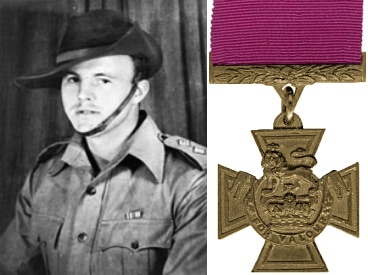
323566 Lieutenant
George Arthur Knowland, V. C.
Royal Norfolk Regiment and No. 1 Commando
31st January 1945, aged 22.
Plot 11. J. 1.
Son of Arthur Philip and Mary Elizabeth Knowland, of Catford, London; husband of Ruby Knowland.
His headstone bears the inscription "Greater Love Hath No Man" Ever Remembered With Love And Pride By His Family
Citation:
The following details are given in the London Gazette of April 10th, 1945 : In Burma on 31st January 1945, near Kangaw, Lieutenant Knowland was commanding a forward platoon subject to very heavy attacks throughout the whole day. In spite of the ferocity of the attacks he moved about encouraging his men and throwing grenades at the enemy, often from completely exposed positions. When the crew of one of his forward bren guns had been wounded, he manned the gun himself, standing on the top of the trench firing and keeping the enemy at a distance until another crew took over. Later he took over a 2-inch mortar and in spite of heavy enemy fire stood in the open firing from the hip, inflicting heavy casualties. When all bombs had been expended he continued to fight the enemy at close quarters with rifle and tommy-gun fire, stemming the assault and killing and wounding many of the enemy, until he himself was mortally wounded. Such was the inspiration of his magnificent heroism, that, though fourteen out of twenty-four of his platoon became casualties at an early stage, and six of his positions were overrun by the enemy, his men held on through twelve hours of continuous and fierce fighting until re-inforcements arrived. If this Northern end of the hill had fallen, the rest of the hill would have been endangered, the beach-head dominated by the enemy, and other units farther inland cut off from their source of supplies. As it was, the final successful counter-attack was later launched from the vital ground which Lieutenant Knowland had taken such a gallant part in holding.
George Arthur Knowland, V. C.
Royal Norfolk Regiment and No. 1 Commando
31st January 1945, aged 22.
Plot 11. J. 1.
Son of Arthur Philip and Mary Elizabeth Knowland, of Catford, London; husband of Ruby Knowland.
His headstone bears the inscription "Greater Love Hath No Man" Ever Remembered With Love And Pride By His Family
Citation:
The following details are given in the London Gazette of April 10th, 1945 : In Burma on 31st January 1945, near Kangaw, Lieutenant Knowland was commanding a forward platoon subject to very heavy attacks throughout the whole day. In spite of the ferocity of the attacks he moved about encouraging his men and throwing grenades at the enemy, often from completely exposed positions. When the crew of one of his forward bren guns had been wounded, he manned the gun himself, standing on the top of the trench firing and keeping the enemy at a distance until another crew took over. Later he took over a 2-inch mortar and in spite of heavy enemy fire stood in the open firing from the hip, inflicting heavy casualties. When all bombs had been expended he continued to fight the enemy at close quarters with rifle and tommy-gun fire, stemming the assault and killing and wounding many of the enemy, until he himself was mortally wounded. Such was the inspiration of his magnificent heroism, that, though fourteen out of twenty-four of his platoon became casualties at an early stage, and six of his positions were overrun by the enemy, his men held on through twelve hours of continuous and fierce fighting until re-inforcements arrived. If this Northern end of the hill had fallen, the rest of the hill would have been endangered, the beach-head dominated by the enemy, and other units farther inland cut off from their source of supplies. As it was, the final successful counter-attack was later launched from the vital ground which Lieutenant Knowland had taken such a gallant part in holding.

273474 Lieutenant
Claud Raymond, V. C.
Royal Engineers
22nd March 1945, aged 21.
Plot 12. G. 9.
Son of Lt.-Col. Maurice Claud Raymond, C.I.E., M.C., and of Margaret Lilias Nancy Raymond (nee Brown), of Fulham, London.
His headstone bears the inscription "I Have Fought A Good Fight, I Have Finished My Course, I Have Kept The Faith"
Citation:
The following details are given in the London Gazette of June 26th, 1945:- In Burma, on 21st March, 1945, Lieutenant Raymond was second in command of a small patrol in the area of Taungup, an area known to be held by numerous enemy strongpoints. As the patrol was moving across an open stretch of ground, it was heavily fired on by an enemy detachment. Lieutenant Raymond immediately charged in the direction of the fire. He was soon twice wounded, but in spite of loss of blood from his wounds, which were later to prove fatal, he continued leading his section under intense fire. In the action which followed, although hit yet a third time, he was largely responsible for the killing of two Japanese and the wounding of a third. The remaining Japanese then fled in panic into the jungle. The position would have proved extremely formidable had not the attack been pressed home with great determination under the courageous leadership of Lieutenant Raymond. The outstanding gallantry, remarkable endurance and fortitude of this officer, which refused to allow him to collapse although mortally wounded was an inspiration to everyone and a major factor in the capture of the strongpoint. His self-sacrifice in refusing attention to his wounds undoubtedly saved the patrol, by allowing it to withdraw in time before the Japanese could bring up fresh forces from neighbouring positions for a counter-attack.
Claud Raymond, V. C.
Royal Engineers
22nd March 1945, aged 21.
Plot 12. G. 9.
Son of Lt.-Col. Maurice Claud Raymond, C.I.E., M.C., and of Margaret Lilias Nancy Raymond (nee Brown), of Fulham, London.
His headstone bears the inscription "I Have Fought A Good Fight, I Have Finished My Course, I Have Kept The Faith"
Citation:
The following details are given in the London Gazette of June 26th, 1945:- In Burma, on 21st March, 1945, Lieutenant Raymond was second in command of a small patrol in the area of Taungup, an area known to be held by numerous enemy strongpoints. As the patrol was moving across an open stretch of ground, it was heavily fired on by an enemy detachment. Lieutenant Raymond immediately charged in the direction of the fire. He was soon twice wounded, but in spite of loss of blood from his wounds, which were later to prove fatal, he continued leading his section under intense fire. In the action which followed, although hit yet a third time, he was largely responsible for the killing of two Japanese and the wounding of a third. The remaining Japanese then fled in panic into the jungle. The position would have proved extremely formidable had not the attack been pressed home with great determination under the courageous leadership of Lieutenant Raymond. The outstanding gallantry, remarkable endurance and fortitude of this officer, which refused to allow him to collapse although mortally wounded was an inspiration to everyone and a major factor in the capture of the strongpoint. His self-sacrifice in refusing attention to his wounds undoubtedly saved the patrol, by allowing it to withdraw in time before the Japanese could bring up fresh forces from neighbouring positions for a counter-attack.

311376 Lieutenant
William Basil Weston, V. C.
Green Howards (Yorkshire Regiment), attached to 1st Bn. West Yorkshire Regiment (Prince of Wales's Own)
3rd March 1945, aged 21.
Plot 20. A. 7.
Son of William Arthur and Rose Weston; nephew of Esther Hathaway, of Dalton-in-Furness. Lancashire.
His headstone bears the inscription "Sistite Paulisper Viatores. Et Pro Anima Mea Orate"
Citation:
The following details are given in the London Gazette of May 11th, 1945:In Burma, on 3rd March, 1945, during the battalion's attack on the town of Meiktila, this officer commanded one of the two platoons leading the attack. Fire was heavy from guns and light automatics situated in well bunkered positions and concrete emplacements. The fighting throughout the day was at very close quarters and at times was hand-to-hand. With magnificent bravery Lieutenant Weston inspired the men of his platoon to superb achievements. Without thought of his own safety he personally led his men into position after position, exterminating the enemy. Throughout, the leadership was superb, encouraging his platoon to the same fanatical zest as was shown by the enemy.
William Basil Weston, V. C.
Green Howards (Yorkshire Regiment), attached to 1st Bn. West Yorkshire Regiment (Prince of Wales's Own)
3rd March 1945, aged 21.
Plot 20. A. 7.
Son of William Arthur and Rose Weston; nephew of Esther Hathaway, of Dalton-in-Furness. Lancashire.
His headstone bears the inscription "Sistite Paulisper Viatores. Et Pro Anima Mea Orate"
Citation:
The following details are given in the London Gazette of May 11th, 1945:In Burma, on 3rd March, 1945, during the battalion's attack on the town of Meiktila, this officer commanded one of the two platoons leading the attack. Fire was heavy from guns and light automatics situated in well bunkered positions and concrete emplacements. The fighting throughout the day was at very close quarters and at times was hand-to-hand. With magnificent bravery Lieutenant Weston inspired the men of his platoon to superb achievements. Without thought of his own safety he personally led his men into position after position, exterminating the enemy. Throughout, the leadership was superb, encouraging his platoon to the same fanatical zest as was shown by the enemy.

273704 Lieutenant
Donald George Webb
2nd Bn. Worcestershire Regiment
19th December 1944, aged 25.
Plot 19. G. 5.
Son of Frederick Charles Webb, and of Emily May Webb, of Gloucester.
Donald George Webb
2nd Bn. Worcestershire Regiment
19th December 1944, aged 25.
Plot 19. G. 5.
Son of Frederick Charles Webb, and of Emily May Webb, of Gloucester.
Pictures © André De Smet


